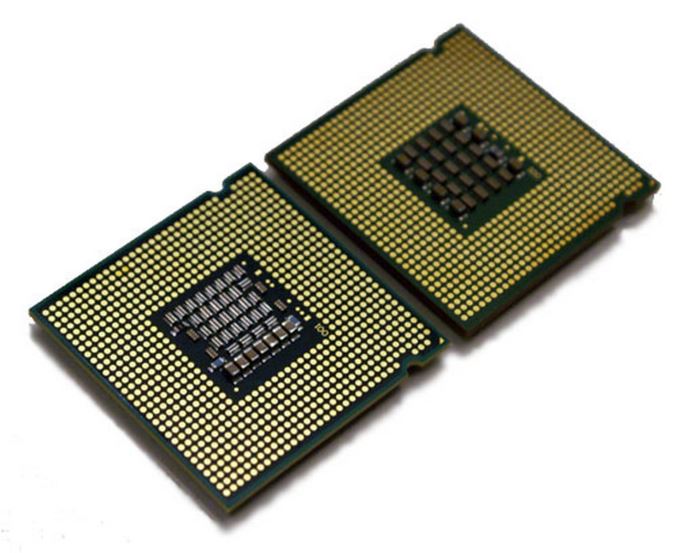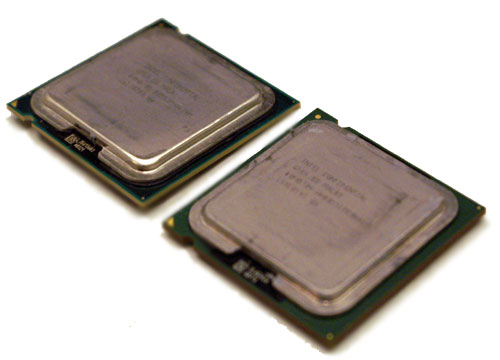Ten Year Anniversary of Core 2 Duo and Conroe: Moore’s Law is Dead, Long Live Moore’s Law
by Ian Cutress on July 27, 2016 10:30 AM EST- Posted in
- CPUs
- Intel
- Core 2 Duo
- Conroe
- ITRS
- Nostalgia
- Time To Upgrade

Today marks a full 10 years since the first Core 2 Duo processors, and hence Intel’s 64-bit Core microarchitecture, were made officially available at retail. These included a number of popular dual-core processor parts, including the seemingly ubiquitous E6400 and the Core 2 Extreme X6800. These were built on Intel’s 65nm process, and marked a turning point in the desktop processor ecosystem. To quote Anand in our launch review: ‘you’re looking at the most impressive piece of silicon the world has ever seen’.
Ten Year Anniversary of Core 2 Duo and Conroe
As part of this piece we will also look at some of the predictions for the future, from the latest (and possibly last) International Technology Roadmap for Semiconductors report, which predicts the stalling of smaller silicon manufacturing nodes over the next 10-15 years.
The first part of this article borrows heavily from Johan’s original look into the Intel Core microarchitecture back in 2006. It’s an awesome read.
Back When I Were A Lad
For a number of our readers, the launch of Conroe was a vast change in the processing landscape. The family of Netburst, Northwood and Prescott processors, in the form of Pentium D and Pentium 4, showed that pursuing the frequency race pushed the silicon far outside its efficiency zone and left a hot, power hungry mess in its wake. It didn’t even come with a muscular V8 sound, and AMD’s Athlon 64 X2 line had taken both the performance and efficiency crown.

Core 2 Duo (left) vs Pentium D (right)
From the perspective of Intel, it had to incorporate a significant paradigm shift in the way it approached the core microarchitecture – no more long pipelines to bump up clock rates to start. The Core microarchitecture design was marketed as a blend of Pentium Pro and Pentium M techniques, as well as the Netburst architecture, however as Johan pointed out at the time, it is significantly Pentium M and it is very hard to find anything Netburst in there. It wasn’t as simple as ‘adding a few functional units or decoders on Yonah and calling it a day’, almost 80% of the architecture and circuit design had to be redone.
As part of this piece, we’re going to take another look at the original architecture improvements of the Core microarchitecture design and some of our old performance metrics from a decade ago.
27th July 2006: Core 2 Launch Day
Ten years ago, Intel launched the following five processors:
| CPU | Clock Speed | L2 Cache |
| Intel Core 2 Extreme X6800 | 2.93GHz | 4MB |
| Intel Core 2 Duo E6700 | 2.66GHz | 4MB |
| Intel Core 2 Duo E6600 | 2.40GHz | 4MB |
| Intel Core 2 Duo E6400 | 2.13GHz | 2MB |
| Intel Core 2 Duo E6300 | 1.86GHz | 2MB |
The X6800 sits at the top with a higher clock speed with a higher supported FSB-to-core ration than previous Intel processors. The Core 2 processors all came from a 143mm2 die, compared the 162mm2 of Pentium D, and they both seem tiny by comparison to the large die sizes we see 2016 for things like the P100. These were chips without integrated graphics either. The introduction of Core 2 pushed the prices of the Pentium D processors down, to give this interesting table:
| CPU | Clock Speed | L2 Cache | Price |
| Intel Core 2 Extreme X6800 | 2.93GHz | 4MB | $999 |
| Intel Core 2 Duo E6700 | 2.66GHz | 4MB | $530 |
| Intel Core 2 Duo E6600 | 2.40GHz | 4MB | $316 |
| Intel Core 2 Duo E6400 | 2.13GHz | 2MB | $224 |
| Intel Core 2 Duo E6300 | 1.86GHz | 2MB | $183 |
| Intel Pentium D 945 | 3.40GHz | 2MBx2 | $163 |
| Intel Pentium D 915 | 2.80GHz | 2MBx2 | $133 |
| Intel Pentium D 820 | 2.80GHz | 1MBx2 | $113 |
| Intel Pentium D 805 | 2.66GHz | 1MBx2 | $93 |
Comparing this to recent Intel processors, and the X8600 matches the list price of the Core i7-5960X (an 8-core part), whereas the popular Core 2 Duo E6400 at $224 at the same price as the Core i5-6600.
A few years ago, I salvaged a super old computer of mine with an E6400 and took it for a spin for a pipeline piece entitled ‘Dragging Core 2 Duo into 2013’. We know that a number of users today are still using the old platform as their day to day machine, and given that it is now celebrating its 10th birthday, it is interesting that anyone wanting to play around with the old hardware can get a motherboard, memory and CPU from eBay for $50-70.
My crusty C2D Setup from 2013











158 Comments
View All Comments
perone - Friday, July 29, 2016 - link
My E6300 is still running fine in a PC I have donated to a friend.It was set to 3GHz within a few days from purchase and never moved from that speed.
Once or twice I changed the CPU fan as it was getting noisy.
Great CPU and great motherboard the Asus P5B
chrizx74 - Saturday, July 30, 2016 - link
These PCs are still perfectly fine if you install an SSD. I did it recently on an Acer Aspire t671 desktop. After modding the bios to enable AHCI I put an 850 evo (runs at sata 2 speed) and a pretty basic Nvidia GFX card. The system turned super fast and runs Windows 10 perfectly fine. You don't need faster processors all you need is get rid of the HDDs.Anato - Saturday, July 30, 2016 - link
I'm still running AMD Athlon x2 4850 2.5GHz as a file server + MythTV box. It supports ECC, is stable and has enough grunt to do its job so why replace. Yes, I could get bit energy efficiency but in my climate >50% of time heating is needed and new hardware has its risks of compatibility issues etc.+10 for anandtech again, article was great as always!
serendip - Sunday, July 31, 2016 - link
I'm posting this on a Macbook with an E6600 2.4 GHz part. It's still rockin' after six years of constantly being tossed into a backpack. The comparisons between C2D and the latest i5 CPUs don't show how good these old CPUs really are - they're slow for hard number crunching and video encoding but they're plenty fast for typical workday tasks like Web browsing and even running server VMs. With a fast SSD and lots of RAM, processor performance ends up being less important.That's too bad for Intel and computer manufacturers because people see no need to upgrade. A 50% performance boost may look like a lot on synthetic benchmarks but it's meaningless in the real world.
artifex - Monday, August 1, 2016 - link
"With a fast SSD and lots of RAM, processor performance ends up being less important."I remember back when I could take on Icecrown raids in WoW with my T7200-based Macbook.
And I actually just stopped using my T7500-based Macbook a few months ago. For a couple years I thought about seeing if an SSD would perk it back up, but decided the memory bandwidth and size limitation, and graphics, was just not worth the effort. Funny that you're not impressed by i5s; I use a laptop with an i5-6200U, now. (Some good deals with those right now, especially if you can put up with the integrated graphics instead of a discrete GPU.) But then, my Macbooks were about 3 years older than yours :)
abufrejoval - Sunday, July 31, 2016 - link
Replaced three Q6600 on P45 systems with socket converted Xeon X5492 at $60 off eBay each. Got 3.4GHz Quads now never using more than 60 Watts under Prime95 (150 Watts "official" TDP), with 7870/7950 Radeon or GTX 780 running all modern games at 1080p at high or ultra. Doom with Vulkan is quite fun at Ultra. Got my kids happy and bought myself a 980 ti off the savings. If you can live with 8GB (DDR2) or 16GB (DDR3), it's really hard to justify an upgrade from this 10 year old stuff.Mobile is a different story, of course.
seerak - Monday, August 1, 2016 - link
My old Q6600 is still working with a friend.The laugher is that he (used to) work for Intel, and 6 months after I gave it to him in lieu of some owed cash, he bought a 4790K through the employee program (which isn't nearly as good as you'd think) and built a new system with it.
The Q6600 works so well he's never gotten around to migrating to the new box - so the 4790k is still sitting unused! I'm thinking of buying it off him. I do 3D rendering and can use the extra render node.
jeffry - Monday, August 1, 2016 - link
Thats a good point. Like, answering a question "are you willing to pay $800 for a new CPU to double the computers speed?" Most consumers say no. It all comes down to the mass market price.wumpus - Thursday, August 4, 2016 - link
Look up what Amazon (and anybody else buying a server) pays for the rest of the computer and tell me they won't pay $800 (per core) to double the computer's speed. It isn't a question of cost, Intel just can't do it (and nobody else can make a computer as fast as Intel, although IBM seems to be getting close, and AMD might get back in the "almost as good for cheap" game).nhjay - Monday, August 1, 2016 - link
The Core 2 architecture has served me well. Just last year I replaced my server at home which was based on a Core 2 Duo E6600 on a 965 chipset based motherboard. The only reason for the upgrade is that the CPU was having a difficult time handling transcoding jobs to several Plex clients at once.The desktop PC my kids use is Core 2 based, though slightly newer. Its a Core 2 Quad Q9400 based machine. It is the family "gaming" PC if you dare call it that. With a GT 730 in it, it runs the older games my kids play very well and Windows 10 hums along just fine.